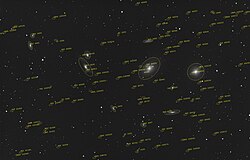Virgo Cluster
The Virgo Cluster is a cluster of galaxies. Its center is 53.8 ± 0.3 million light years (16.5 ± 0.1 million parsecs) away from Earth, in the constellation Virgo.[1] The cluster forms the heart of the larger Virgo Supercluster, of which our Local Group is an outlying member.
The Virgo Cluster has about 1300 (and perhaps up to 2000) member galaxies.[2] Its mass is about 1.2×1015 solar masses out to 8 degrees of the cluster's center or a radius of about 2.2 million parsecs.[3]
Many of the brighter galaxies in this cluster, including the giant elliptical galaxy Messier 87 and brightest member Messier 49, were discovered in the late 1770s and early 1780s. They were included in Charles Messier's catalogue of non-cometary fuzzy objects. Described by Messier as nebulae without stars, their true nature was not recognized until the 1920s.[4] Many of the member galaxies of the cluster are visible with a small telescope. Its brightest member is the elliptical galaxy Messier 49.
Virgo Cluster Media
Turbulence may prevent galaxy clusters from cooling (Chandra X-ray).
Map of the Virgo Supercluster centered on the Local Group (image diameter 200 Mly ≈ 60 Mpc). The Virgo Cluster is visible in the center right of the image, at about 50 Mly from the Local Group.
References
- ↑ Mei, Simona; et al. (2007). "The ACS Virgo Cluster Survey. XIII. SBF Distance Catalog and the Three-dimensional Structure of the Virgo Cluster". The Astrophysical Journal. 655 (1): 144–162. arXiv:astro-ph/0702510. Bibcode:2007ApJ...655..144M. doi:10.1086/509598. S2CID 16483538.
- ↑ See Virgo Cluster
- ↑ Fouqué P.; et al. (2001). "Structure, mass and distance of the Virgo cluster from a Tolman-Bondi model". Astronomy and Astrophysics. 375 (3): 770–780. arXiv:astro-ph/0106261. Bibcode:2001A&A...375..770F. doi:10.1051/0004-6361:20010833. S2CID 10468717.
- ↑ Following the entry for M91 in the Connoissance des Temps for 1784, Messier added the following note:
- The constellation of Virgo, & especially the northern Wing is one of the constellations which encloses the most Nebulae: this Catalog contains thirteen which have been determined: viz. Nos. 49, 58, 59, 60, 61, 84, 85, 86, 87, 88, 89, 90, & 91. All these nebulae appear to be without stars: one can see them only in a very good sky, & near their meridian passage. Most of these nebulae have been pointed to me by Mr. Méchain. (see M91 Archived 2008-05-16 at the Wayback Machine.)



